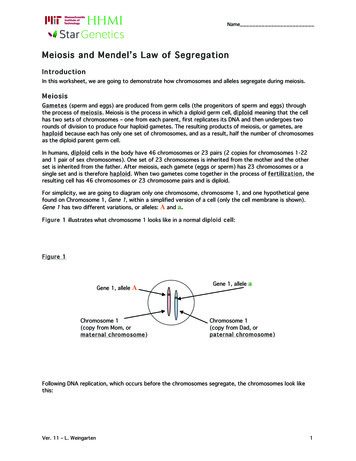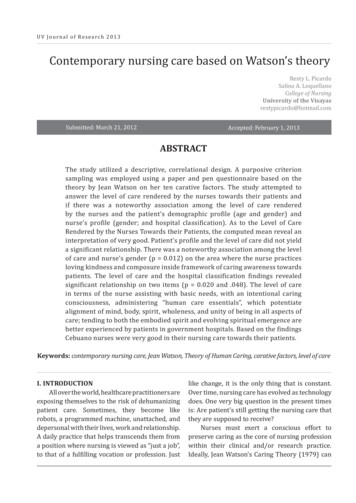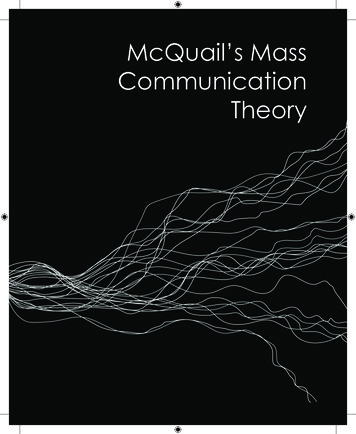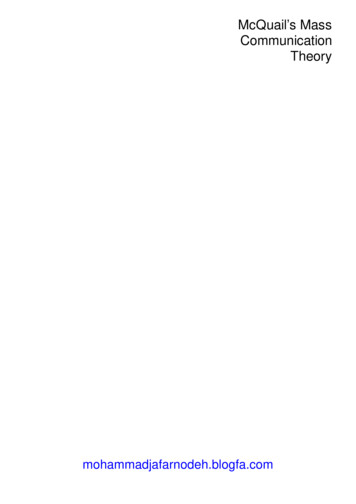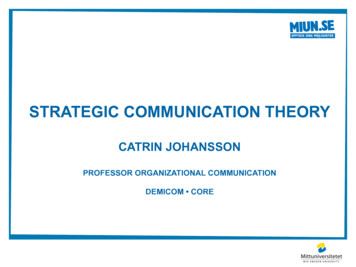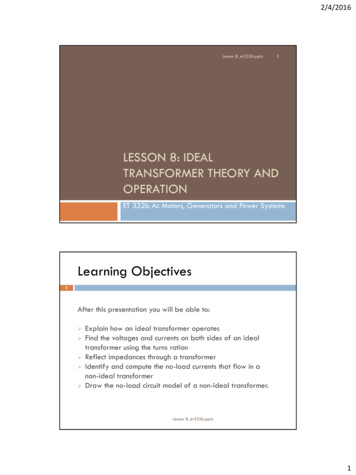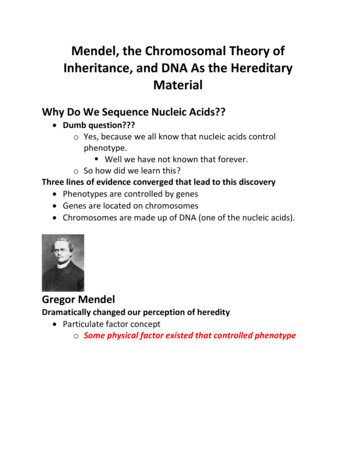
Transcription
Mendel, the Chromosomal Theory ofInheritance, and DNA As the HereditaryMaterialWhy Do We Sequence Nucleic Acids? Dumb question?o Yes, because we all know that nucleic acids controlphenotype. Well we have not known that forever.o So how did we learn this?Three lines of evidence converged that lead to this discovery Phenotypes are controlled by genes Genes are located on chromosomes Chromosomes are made up of DNA (one of the nucleic acids).Gregor MendelDramatically changed our perception of heredity Particulate factor concepto Some physical factor existed that controlled phenotype
Traits have a dominant and recessive forms Proofo F1 generation Dominant form appears Recessive form disappears F2o Recessive form reappearsMendel’s 1st Law, the Law of Segregation A single form of the factor controlling phenotype was passed tothe gamete during reproduction.o Event occurs during reduction step of meiosis One of two forms of the factor was passed through the gamete tothe offspring.o Proof? F2 3:1 ratio in F2 generation segregating for onetraito 3/4 dominant formo 1/4 recessive form F3 generation Offspring of recessive F2 plants all recessive form Some offspring of F2 dominant form plants alldominant form Some offspring of F2 dominant form plantsproduce 3:1 dominant to recessive forms Ratio of dominant form F2 plants in F3 generationo 2/3 segregate for dominant and recessiveforms in 3:1 ratioo 1/3 all dominant F3 plants
Mendel’s 2nd Law, the Law of Independent Assortment Each trait was controlled by a unique factor Proof?o 9:3:3:1 ratio in the F2 generation segregating for two traits The cross product of two 3:1 ratios is 9:3:3:1Mendel DID not consider the actual physical entity that controlsexperimentso Others discovered that entityOther experiments determined Mendel’s factors (genes) reside on chromosomes DNA was the heredity material.Naming the Mendelian Laws Correns (1900)o Referred to segregation and assortment Morgan (1916)o First to use the terms: Law of Segregation Law of Independent Assortment
Genes Reside on ChromosomesEduard Strasburger (1876) Cell division is a universal activity of all higher organismso Same process is observed in plantsWalther Flemming (1878) Structures had a string like appearance to themo Termed the structures chromatin (or colored substance) Also developed the concept of cell divisiono Called cell division mitosis.
Edouard van Beneden (1883) Egg cell sperm cell fertilizationo Resulting cell has the diploid chromosome number Sperm and egg cello Each contribute equal numbers of chromosomes to thezygote Discovered meiosisHeinrich Wilhelm Gottfried von Waldeyer-Hartz (1888) Called the structures dividing during mitosis chromosomeso Chromosomes ( colored bodies)
August Weismann (1892) Germline Theoryo Sperm and egg cells Contain exactly half the number of chromosomes Transmit hereditary informationo Somatic cells Carry out normal body functions
Hugo deVries (1889 on)Performed hybridization experiments and discovered Each trait controlled by a different factoro Observed 3:1 ratio in F2 Called the hereditary factor a pangene Individual pangenes controlled all traitso Pangenes located in the cell of a diploid organismInitially unaware that Mendel proved this earlier Later tried to publish without referencing Mendelo Correns corrected him Admitted that Mendel was the first to discover thelaws of geneticsConsidered pangenes Larger than a single chemical moleculeo But still invisibleReproductive cells Receive half of the pangenes during meiosiso When reproductive cells unite Diploid number of pangenes is restoredFirst linkage between inheritance and reproductive cells
Carl Correns (1900) Study inheritance in plantso Published results in paper “G. Mendel's Law Concerning the Behavior of theProgeny of Racial Hybrids"Erich Tschermak (1900) Plant breeder working on wheat, barley, and oatso Tried to combine earliness and high yield Considered the "father" of Austrian plant breeding Did genetic experiments with peao Referenced Mendel in his publicationRediscovering Mendel’s Concepts of Genetics Referenced in publications by:o DeVries (April 1900)o Correns (May 1900)o Tschemark (August ? 1900)
Chromosome Theory of Inheritance (1902-1903)Chromosomes are the carrier of Mendelian factors and meiosis is thebasis of separating the factors into gametes.Theodor Boveri (1902) Observedo All male and female chromosome must be present todevelop a functioning organismo Linked chromosomes and the factors that were described byMendel Quoteo " the characters dealt with in Mendelian experiments aretruly connected to specific chromosomes."Walter Sutton (1902) Described chromosomes as unique individual unitso That occur in pairso Separate during meiosis Quote Chromosomes ".may constitute the physical basis of theMendelian law of heredity."
Linking Genes and ChromosomeThomas Hunt Morgan and Calvin BridgesThomas Hunt Morgan (1910) Discovered a mutant white eye Drosophilao Different than the wild type red eye Performed genetic experimentso Results proved the eye color gene was located on the XchromosomeCalvin Bridges (1914) Studied Morgan’s white eye mutanto Coupled the presence of the X chromosome with a specificeye coloro Conclusively demonstrated genes indeed reside onchromosomes
Problem with this concept!! Chromosomes carried the genetic informationo They must contain all the genetic factors But, the number of chromosomes is less than the number oftraits.o Now it was essential to show chromosomes contain manyfactorsSolution: Multiple Genes Reside on Chromosome!! Sturtevant, Bridges, Morgan (1919)o Mated among Drosophila with several different contrastingphenotypes Multiple genes are organized into a linear linkagegroup Number of linkage groups equals the number ofchromosomesIt could now be stated:All features necessary for a hereditary unit are found inchromosomes!!!
Position EffectSturtevant (1925) If the physical environment of a gene is alteredo Expression of the gene is affected Thereforeo Physical structure of the chromosome is essential for thecorrect phenotypic expressionFrom a modern perspective This is the first solid evidence that we should take a genomicsapproach to fully understand gene expression. Thereforeo Completely characterizing ( sequencing) all of the geneticmaterial in the cell is necessary.SO WHAT IS THE GENETIC MATERIAL?
History of DNA As the Genetic MaterialErnst Haeckel (1866) Nucleus transmitted hereditary information to the nextgenerationFriedrich Miescher (1871-1874)Studied pus cells collected from bandages from surgeries Collected white blood cells White blood cells primarily composed of nucleio Called this nuclear material nucleinDetermined that nuclein contained two classes of chemicals Acidic componento Now we know the component is DNA and RNA Basic componento Now know that is histone proteins
Linking DNA and HeredityFred Griffith (1928) Worked with lethal and non-lethal strains of the Streptococcuspneumoniaeo Converted a non-lethal strain to a lethal strain Conversion involvedo Mixing dead lethal and live non-lethal strainsGriffith's Transforming principle Converts one phenotype to anothero This is the true nature of a geneo These are two alleles of the same gene So what is the chemical nature of the transforming principle?
Oswald AveryColin MacLeoudMaclyn McCartyAvery, MacLeod, and McCarty (1944) Transforming principleo DNA was the transforming principle(from the acidiccomponent)o Not protein or RNA The other two constituents in the nucleus.RNA Is Also A Genetic Material Heinz Fraenkel-Conrat (1957)o RNA viruses exist Interconverted strains of tobacco mosaic virus RNA mediated the interconversion and can be agenetic material
Chemical Structure of DNAJames Watson and Francis Crick (1953) DNA is double-stranded Strands are oriented in an anti-parallel manner to each other Purines nucleotides are opposite pyrimidines nucleotideso Guanine hydrogen bonds with cytosineo Adenine hydrogen bonds with thymine Structure is stabilized byo Hydrogen bondso Hydrophobic bonding between stacked basesWatson and Crick Did not perform any experimentso Based on research of others
Research results of others that aided Watson and Crick Erwin Chargaffo Concentrations of guanine and cytosine were always equalin DNAo Concentrations of adenine and thymine were equal in DNA Rosalind Franklin and Maurice Wilkins:o Used X-ray crystallography to study structure of DNAWatson and Crick major contributions to describing the structure of DNA had a repeating structures (nucleotides) DNA was of a constant width DNA was double-stranded
Chromosome Theory of Inheritance (1902-1903) Chromosomes are the carrier of Mendelian factors and meiosis is the basis of separating the factors into gametes. Theodor Boveri (1902) Observed o All male and female chromosome must be present to develop a functioning organism o Linked

